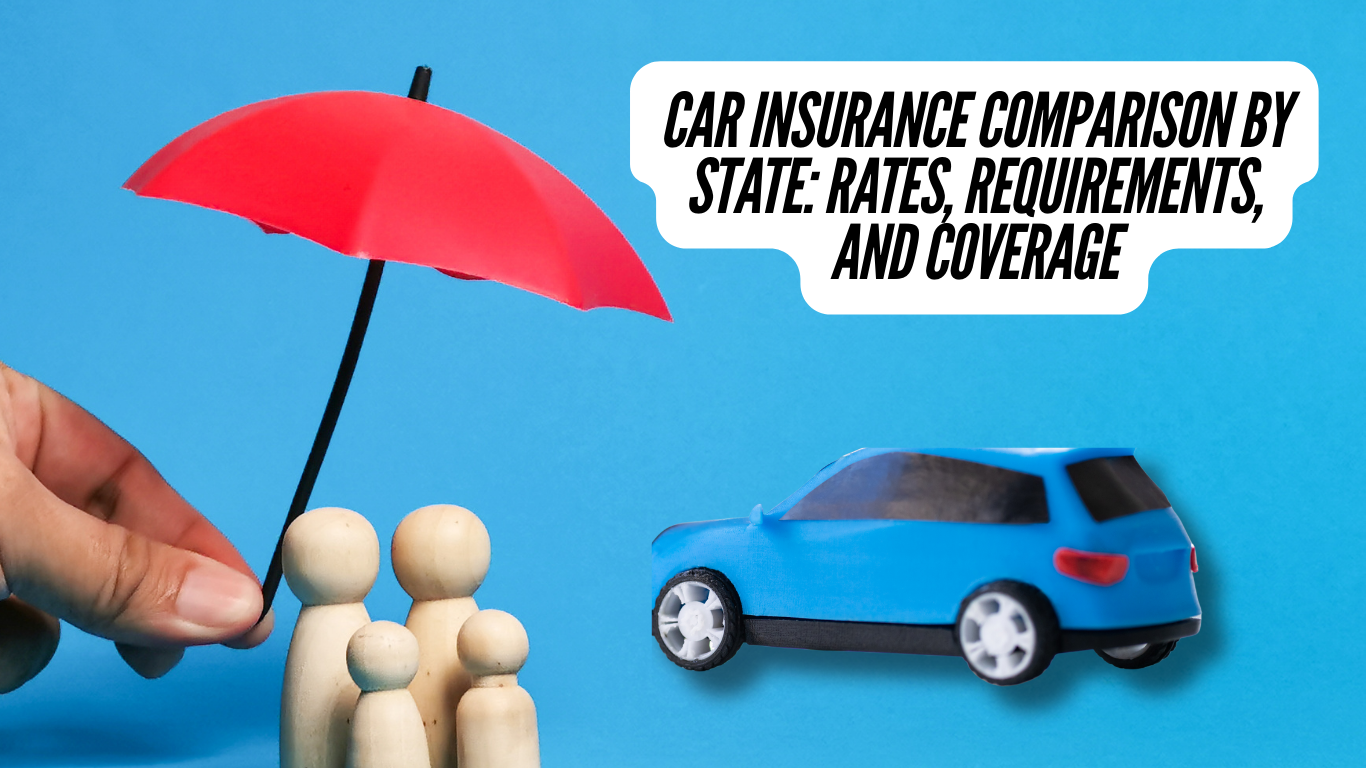Car Insurance Comparison by State: A Complete Guide to Rates, Requirements, and Coverage
Table of Contents
Comparing car insurance costs and coverage across states is essential for finding the best policy to meet your needs. Insurance prices vary widely from state to state due to a mix of factors, including local laws, accident rates, and coverage requirements. In this guide, we’ll break down car insurance by state, provide insights into why rates differ, and help you understand the requirements and top providers in each region. Let’s dive in to see how much you can save by comparing your options. ( Car Insurance Comparison by State )
Why Car Insurance Rates Vary by State
Understanding why insurance rates fluctuate across states can help you better navigate your choices. Key factors that impact rates by state include:
- State Regulations: States set minimum insurance requirements, impacting the baseline cost.
- Population Density and Traffic: More populated areas often have higher accident rates, leading to pricier insurance.
- Weather and Road Conditions: States with extreme weather or poor road conditions may experience more claims.
- Medical and Repair Costs: States with higher healthcare or vehicle repair costs will see insurance prices rise accordingly.
- Insurance Fraud Rates: States with higher instances of fraud typically have more expensive premiums.
These variables create a unique insurance landscape in each state, underscoring the importance of a detailed state-by-state comparison. ( Car Insurance Comparison by State )
Minimum Coverage Requirements by State
Each state has different requirements for minimum car insurance coverage, generally including liability insurance, uninsured motorist coverage, and, in some cases, personal injury protection (PIP). Here’s a breakdown of these common types of coverage:
- Liability Insurance: Covers damage to others’ property and medical expenses due to an accident you cause.
- Uninsured/Underinsured Motorist Coverage: Protects you if you’re involved in an accident with an uninsured or underinsured driver.
- Personal Injury Protection (PIP): Covers medical expenses for you and your passengers, required in no-fault states.
These minimum requirements influence the base price for insurance in each state. Below, we cover specific insurance requirements in key regions across the U.S.
States with No-Fault Insurance
No-fault insurance states require that each driver’s insurance cover their medical bills, regardless of who caused the accident. These states include:
- Florida
- Michigan
- New Jersey
- New York
- Pennsylvania
These states tend to have higher insurance rates due to the additional PIP requirement.
( Car Insurance Comparison by State )
Average Car Insurance Rates by State
Here’s a look at the average annual premiums for each state, based on factors like coverage level, accident frequency, and local cost of living.
| State | Average Annual Premium (Full Coverage) | Minimum Coverage Average |
|---|---|---|
| Alabama | $1,358 | $427 |
| Alaska | $1,287 | $415 |
| California | $2,065 | $733 |
| Florida | $2,364 | $882 |
| Texas | $1,823 | $611 |
| Michigan | $2,309 | $947 |
| New York | $2,321 | $1,062 |
The above figures give a snapshot of state averages. For more precise calculations, individual driving history, location, and coverage options should be considered.
Top Car Insurance Providers by State
Many national insurance companies serve across all states, but certain providers offer better rates or unique benefits in specific regions. Here’s a breakdown of top providers by state:
California
- Best Overall: Geico – Known for competitive rates.
- Best for High Coverage: State Farm – Offers extensive policies for comprehensive needs.
Florida
- Best Value: Progressive – Competitive rates and a strong online presence.
- Best for Seniors: Allstate – Offers discounts for retirees and safe drivers.
Texas
- Best for Families: Nationwide – Family plans with excellent bundled discounts.
- Best Local Provider: Texas Farm Bureau – Lower premiums for residents.
Michigan
- Best for High-Risk Drivers: Progressive – Lenient policies for high-risk drivers.
- Best Local Support: AAA – High customer satisfaction and local agents available.
These providers excel based on local regulations, state-specific discounts, and their ability to accommodate state-driven coverage requirements.
Cost-Saving Tips for Car Insurance in Different States
Saving on car insurance involves more than just choosing the lowest premium; it’s about finding value for your specific needs. Here are some tips for securing better rates:
- Shop Around Annually: Prices can vary year-to-year, so it’s wise to check for competitive offers.
- Ask About Discounts: Look for discounts for safe driving, multiple vehicles, and loyalty.
- Adjust Deductibles: Opting for a higher deductible can reduce monthly premiums.
- Bundle Policies: Many insurers offer discounts if you bundle auto and home insurance.
- Review Coverage Periodically: Only pay for coverage you truly need. For example, if you drive an older car, you may consider dropping collision coverage.
These strategies can result in significant savings, especially in states with higher insurance costs. ( Car Insurance Comparison by State )
Understanding Car Insurance Deductibles and Limits
Deductibles and coverage limits are important aspects of any car insurance policy. Here’s what you need to know:
- Deductible: The amount you’ll pay out of pocket before insurance kicks in. Higher deductibles lower your premium but increase your risk.
- Coverage Limit: The maximum amount the insurer will pay for a claim. Higher limits provide better protection but at a higher cost.
Balancing your deductible and coverage limit can optimize costs without compromising on necessary protection, especially important in states with higher accident rates.
The Impact of Credit Scores on Insurance Rates by State
In many states, insurers consider credit scores when determining rates. Higher credit scores often mean lower premiums due to perceived lower risk. However, some states restrict or prohibit this practice:
- States Prohibiting Credit-Based Rates: California, Hawaii, Massachusetts, and Michigan have laws preventing credit score use for insurance pricing.
Understanding how credit affects rates can give you more control over your premium. In states where it’s allowed, maintaining a healthy credit score can yield significant savings.
States with the Lowest Car Insurance Rates
Certain states consistently rank as the most affordable for car insurance:
- Maine: The average premium is $876 annually for full coverage.
- Iowa: Average annual premium of $1,025.
- Idaho: Costs around $1,018 per year on average.
These states benefit from low population density, fewer road accidents, and generally milder weather conditions, contributing to lower insurance premiums.
States with the Highest Car Insurance Rates
Conversely, these states have the highest car insurance costs due to factors like dense populations and frequent severe weather:
- Michigan: Average annual premium of $2,309.
- Florida: Annual premium averages $2,364.
- New York: Premiums around $2,321 annually.
For residents in these states, comparison shopping and adjusting coverage are essential steps to manage insurance costs.
How State Laws Affect Car Insurance Claims
State-specific regulations play a big role in how claims are processed. Here’s a look at some of these variations:
- No-Fault vs. Fault States: In no-fault states, each driver’s insurance pays for their medical expenses.
- Mandatory Coverage: Some states mandate additional types of coverage, such as uninsured motorists or PIP, increasing the base cost.
Knowing your state’s insurance laws can guide you in selecting the most appropriate coverage level. ( Car Insurance Comparison by State )
Conclusion ( Car Insurance Comparison by State )
Navigating car insurance by state is a complex but necessary process to ensure you get the best possible rate without sacrificing essential coverage. State regulations, average rates, top providers, and local conditions all contribute to the cost and coverage options available to you. By comparing rates, leveraging discounts, and tailoring coverage to state-specific needs, you can save money while staying protected. ( Car Insurance Comparison by State )
FAQs
1. How does my state impact my car insurance rate?
Each state has its minimum insurance requirements and risk factors that contribute to the cost of car insurance. Population density, weather, and local laws all play a role in setting rates.
2. What is the cheapest state for car insurance?
States like Maine, Iowa, and Idaho are known for their low average premiums, thanks to fewer accidents, mild weather, and affordable healthcare costs.
3. Can I reduce my insurance cost if I move to a cheaper state?
Moving to a state with lower average premiums can reduce your car insurance cost, but the exact amount will depend on other factors like your driving history and the specific location.
4. Are there any states that don’t allow credit scores in determining car insurance rates?
Yes, states like California, Hawaii, Massachusetts, and Michigan prohibit insurers from using credit scores to set insurance rates.
5. What are the best car insurance providers by state?
It varies. Major companies like Geico, State Farm, and Progressive have strong nationwide coverage, but some local providers also offer competitive rates and services specific to certain states.





